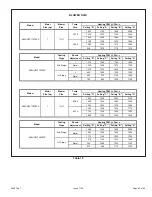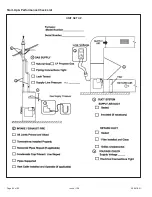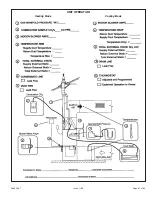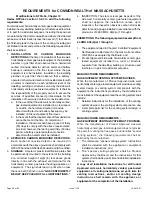
506878-01
Page 56 of 62
Issue 1139
Service
At the beginning of each heating season, system should be
checked as follows by a qualified service technician:
Blower
Check the blower wheel for debris and clean if necessary.
The blower motors are prelubricated for extended bearing
life. No further lubrication is needed.
The blower access panel must be securely in place when
the blower and burners are operating. Gas fumes, which
could contain carbon monoxide, can be drawn into living
space resulting in personal injury or death.
WARNING
Filters
All air filters are installed external to the unit. Filters should
be inspected monthly. Clean or replace the filters when
necessary to ensure proper furnace operation. Table 1 lists
recommended filter sizes.
Exhaust and air intake pipes
Check the exhaust and air intake pipes and all connections
for tightness and to make sure there is no blockage.
NOTE:
After any heavy snow, ice or frozen fog event the
furnace vent pipes may become restricted. Always check
the vent system and remove any snow or ice that may be
obstructing the plastic intake or exhaust pipe
s.
Electrical
1. Check all wiring for loose connections.
2. Check for the correct voltage at the furnace (furnace
operating).
3. Check amp-draw on the blower motor.
Motor Nameplate__________Actual__________
ELECTRICAL SHOCK, FIRE,
OR EXPLOSION HAZARD.
WARNING
Failure to follow safety warnings exactly could result in
dangerous operation, serious injury, death or property
damage.
Improper servicing could result in dangerous operation,
serious injury, death, or property damage.
Before servicing, disconnect all electrical power to
furnace.
When servicing controls, label all wires prior to
disconnecting. Take care to reconnect wires correctly.
Verify proper operation after servicing.
Winterizing and Condensate Trap Care
1. Turn off power to the furnace.
2. Have a shallow pan ready to empty condensate water.
3. Remove the clean out cap from the condensate trap
and empty water. Inspect the trap then reinstall the clean
out cap.
Cleaning Heat Exchanger
If cleaning the heat exchanger becomes necessary, follow
the below procedures and refer to Figure 1 when
disassembling unit. Use papers or protective covering in
front of furnace while removing heat exchanger assembly.
1. Turn off electrical and gas supplies to the furnace.
2. Remove the burner access panel.
3. Mark all gas valve wires and disconnect them from
valve.
4. Remove gas supply line connected to gas valve.
5. Remove sensor wire from flame sensor. Disconnect
2–pin plug from the ignitor.
6. Disconnect wires from flame rollout switches.
7. Remove four burner assembly screws at the vestibule
panel and remove gas valve /manifold and burner box
as a single unit.
8. If necessary, clean burners at this time. Follow
procedures outlined in Burner Cleaning section.
9. Remove the clean-out cap on trap and drain. Replace
cap.
10. Disconnect condensate drain line from the condensate
trap. Remove condensate trap (it may be necessary to
cut drain pipe). Remove the 1/2" NPT fitting from the
cold end header box. Disconnect drain tubes from cold
end header collector box.
11. Disconnect condensate drain tubes from flue collar.
Remove screws that secures flue collar in place.
Remove flue collar. It may be necessary to cut the
exiting exhaust pipe for removal of the fitting.
12. Loosen two clamps from flexible no-hub exhaust collar.
13. Disconnect the 2–pin plug from the combustion air
inducer. Remove screws which secure combustion air
inducer to collector box. Remove combustion air
inducer assembly. Remove ground wire.
14. Mark and disconnect all combustion air pressure tubing
from cold end header collector box.
15. Mark and remove wires from pressure switch. Remove
pressure switch. Keep tubing attached to pressure
switch.
16. Remove electrical junction box from the side of the
furnace.
17. Remove blower access panel.
18. Mark and disconnect any remaining wiring to heating
compartment components. Disengage strain relief
bushing and pull wiring and bushing through the hole in
the blower deck.
19. Remove the primary limit from the vestibule panel.
20. Remove top cap screws to allow top cap to be tilted
upward to allow clearance for removing heat exchanger.
Summary of Contents for 95G2UHV
Page 3: ...506878 01 Page 3 of 62 Issue 1139 EXPANDED VIEW Figure 1 ...
Page 28: ...506878 01 Page 28 of 62 Issue 1139 Figure 31 FIELD SUPPLIED WALL TERMINATION ...
Page 29: ...506878 01 Page 29 of 62 Issue 1139 Figure 32 ...
Page 35: ...506878 01 Page 35 of 62 Issue 1139 Figure 47 TRAP DRAIN ASSEMBLY USING 1 2 PVC or 3 4 PVC ...
Page 46: ...506878 01 Page 46 of 62 Issue 1139 TYPICAL WIRING DIAGRAM Figure 56 ...
Page 60: ...506878 01 Page 60 of 62 Issue 1139 Start Up Performance Check List UNIT SET UP ...
Page 61: ...506878 01 Page 61 of 62 Issue 1139 UNIT OPERATION Heating Mode Cooling Mode ...





































